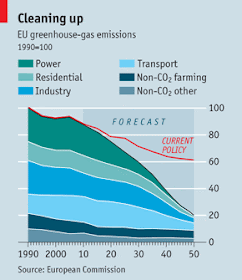“Believing that global greenhouse-gas emissions must fall by half to limit climate change, and that rich countries should cut the most, Europe has set a goal of reducing emissions by 80-95% by 2050. The road map is its first stab at sharing out the cuts.”This chart indicates the scale of the plan.
This would be no small undertaking, requiring a significant investment over a long period.
“The plan requires a lot of investment in power generation and smarter grids, best done in the context of—at long last—a reformed and competitive energy market. The commission says the investment required to decarbonise power would average about €30 billion ($42 billion) a year over 40 years. This is one of the cheaper parts of the plan; the total cost is about €270 billion a year, with €80 billion going on buildings and appliances and €150 billion on transport. But the commission’s modelling also points to savings on fuel costs, which are low for nuclear and zero for most renewables, of between €175 billion and €320 billion. Other benefits include more energy security and cleaner air.”Interestingly, some countries want to accelerate the plan even though meeting its short-term targets is not a certainty.
“Some governments, including France’s and Britain’s, are so convinced of the benefits of green investment that they think the commission’s near-term goal of a 20% emission reduction by 2020 is too low. They want it raised to 30%. Others argue strenuously for the limit to be kept as it is, as do some industry lobbies. The road map says that an optimal path would require a larger cut by 2020—but that, as luck would have it, the optimal reduction, set at 25%, is what will be realised by existing plans for more renewable energy and improved energy efficiency if they work out.”To balance natural carbon emissions, power generation will have to go to essentially zero emission. About half of today’s power comes from fossil fuels. It is not practical to eliminate that dependence entirely. Consequently, the plan depends on carbon sequestration to meet its goals.
“One problem with this is that the efficiency goal of a 20% improvement by 2020 seems high. The commission says the EU is on course to do only half as well. In an energy-efficiency plan released with its road map, the commission talks of making the goals binding in 2013.”
“The biggest technical caveat is that most studies include a lot of fossil-fuel plants in which carbon dioxide is whisked out of chimneys and tucked underground without troubling the atmosphere, and this capture and storage technology has yet to be proved on the scale needed.”A good summary of sequestration technologies can be found here. The inevitability of continued worldwide coal burning for power generation is discussed here. Given that this is such a crucial element in the quest for carbon emissions reduction, one would think there would be more urgency in the quest to demonstrate sequestration technology. While there are significant efforts underway, one might expect that something on the scale of the Manhattan Project would be more appropriate.
Props to the EU for at least realizing what needs to be done. Let’s wish them well.

No comments:
Post a Comment